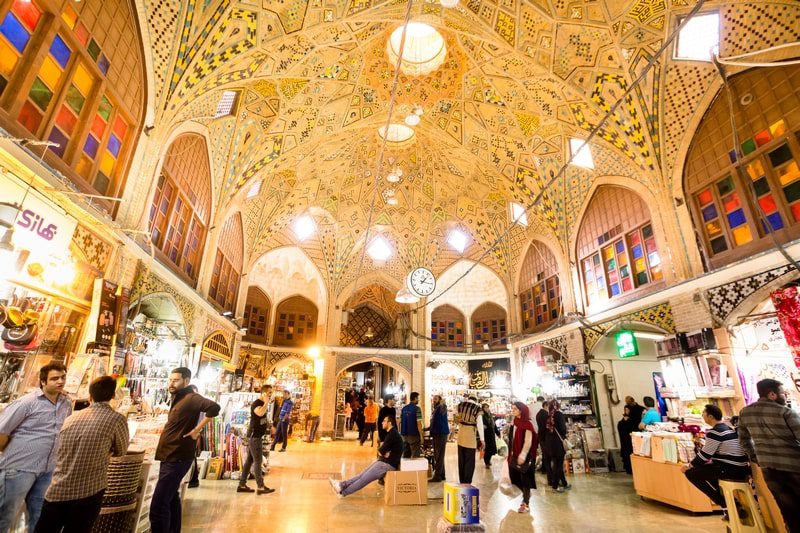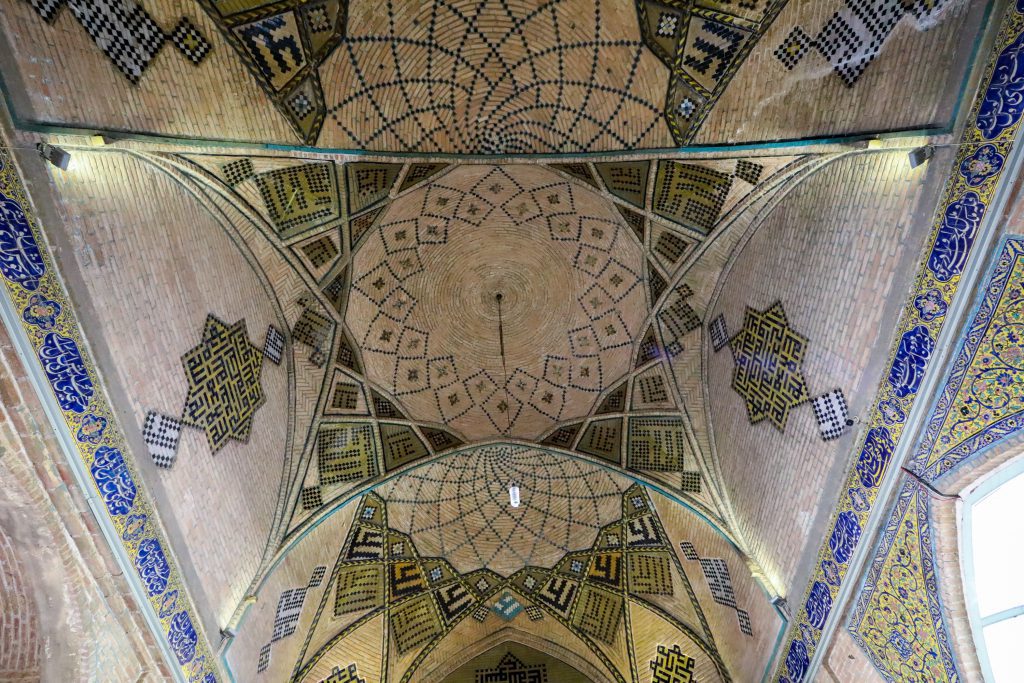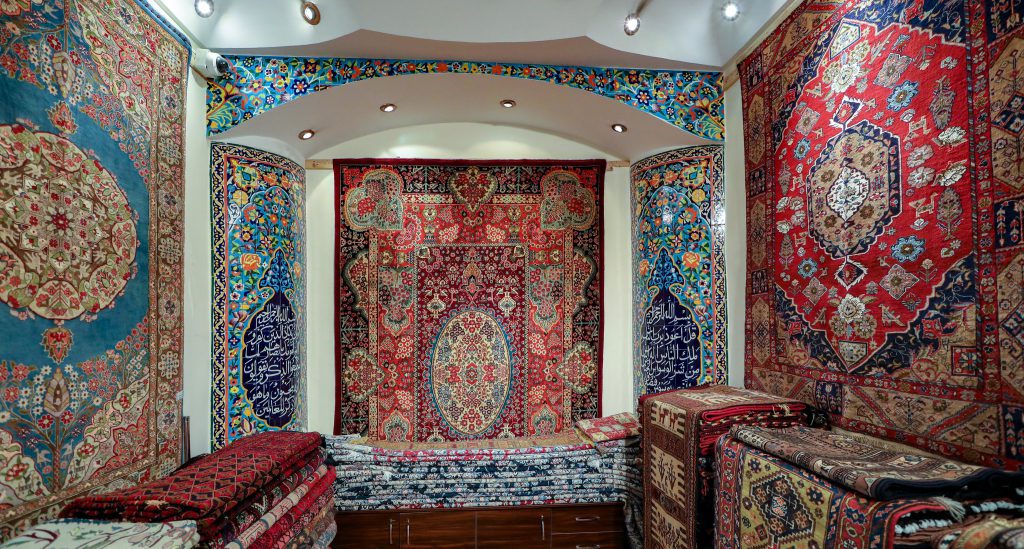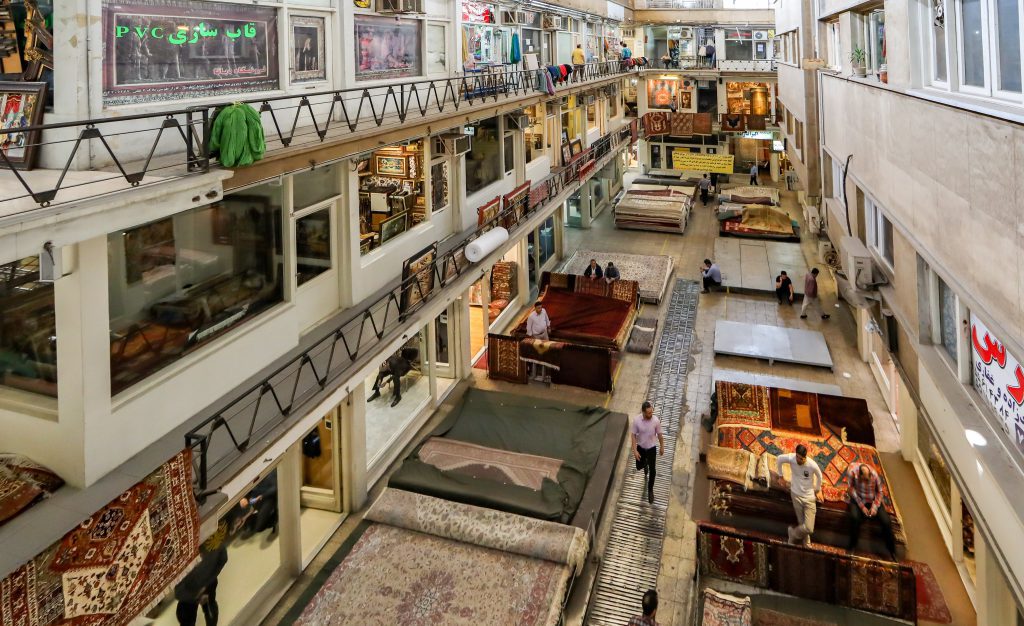Table of Contents
Why Visiting Tehran Grand Bazaar?
Tehran Grand Bazaar, a treasure trove of culture and history, beckons travelers from all corners of the globe. It is one of the oldest and most expansive covered markets not only in Iran but also in the world. In this guide, we will delve into the allure of the Tehran Grand Bazaar and discover why it’s an absolute must-visit during your stay in the Iranian capital.
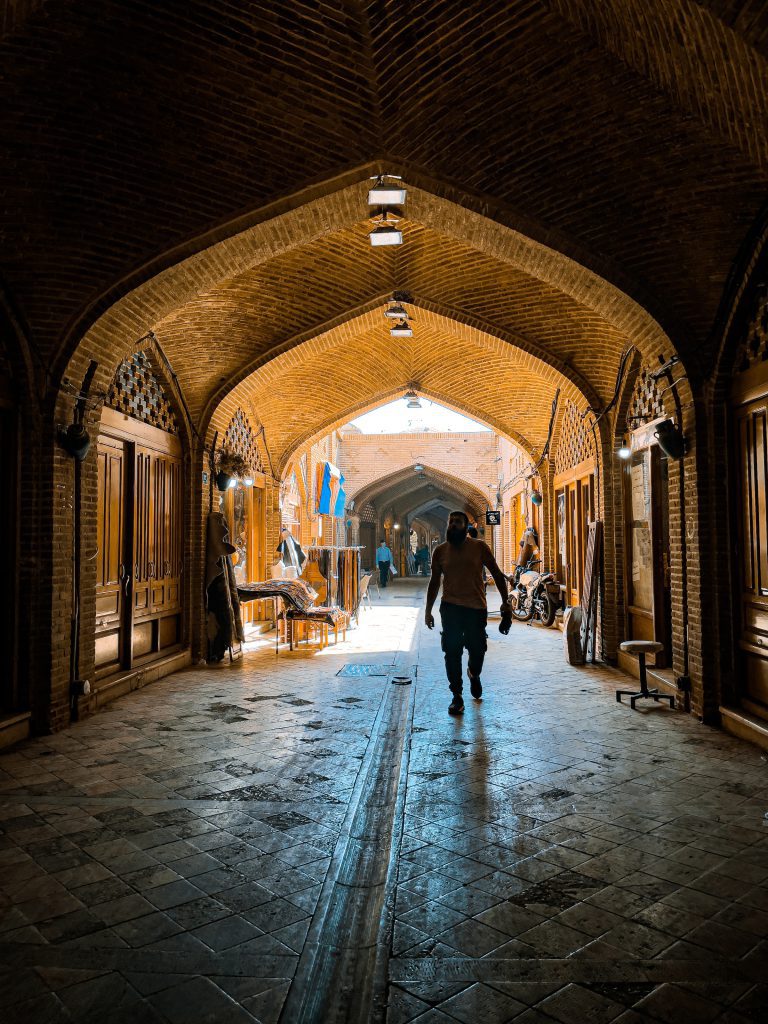
Spanning a vast expanse of about 10 square kilometers, Tehran Grand Bazaar is akin to a thriving city within a city. Its labyrinthine alleys and passages hide a multitude of captivating treasures. Here, you’ll find not only shops, but also mosques, restaurants, tea houses, unique architectural marvels, shrines, mausoleums, banks, accommodations, and so much more.
Getting Lost in the Grandeur of Tehran Bazaar
Visiting the Tehran Grand Bazaar is like stepping into a world where time-honored traditions meet modern-day commerce. As you navigate the bazaar’s meandering paths, you might find yourself metaphorically “lost” in the sheer beauty and the unique atmosphere that envelopes this remarkable place.
Gaze upward, and you’ll be captivated by the intricate beauty of the ceiling, which is a true testament to the artisans who crafted it. But it’s not just the architecture that’s enchanting; it’s also the welcoming demeanor of the shop owners, who are eager to share their knowledge and wares with you.
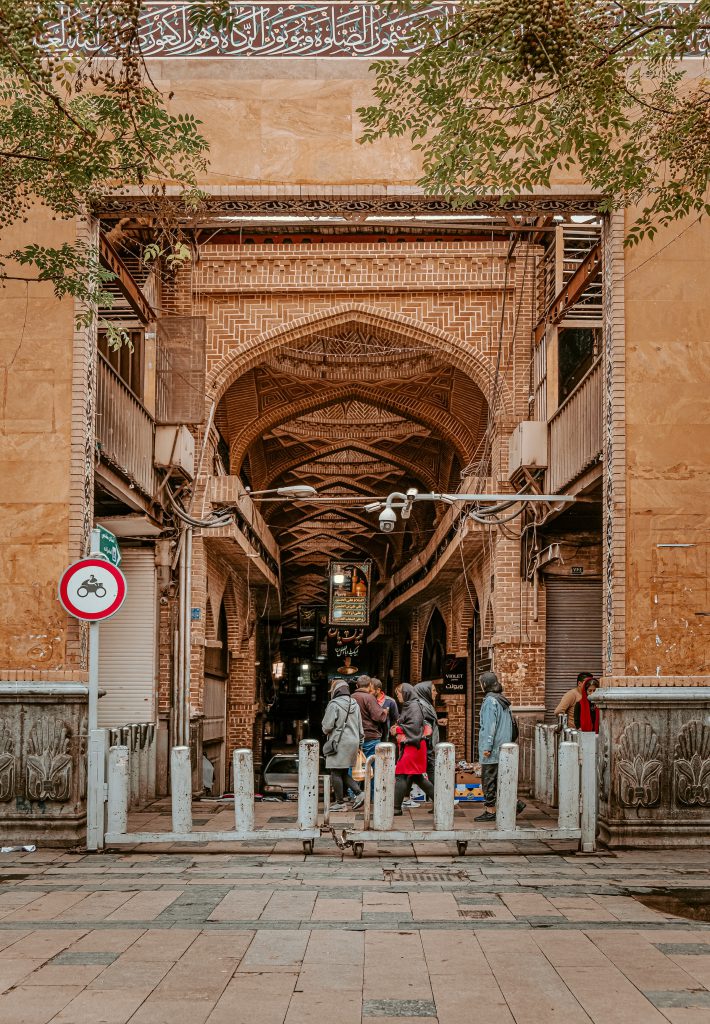
However, you may also find yourself quite literally lost in the vast expanse of shopping rows and corridors, each offering a tantalizing array of products and souvenirs. It’s easy to become enthralled by the distinctive sounds and lively crowds, the rich tapestry of smells wafting from various stalls, and the visually stunning sights that surround you.
Tehran Grand Bazaar: More than Shopping
The appeal of Tehran Grand Bazaar transcends mere commerce. While it’s undoubtedly a shopper’s paradise, it’s also a place where history and culture come to life.
In the following sections, we will explore fascinating facts about the Tehran Grand Bazaar, including its opening hours, the diverse array of shops you can encounter, and what makes this bazaar in Tehran a truly unique experience. So, whether you’re a seasoned traveler or just embarking on your journey of discovery, the Tehran Grand Bazaar promises a memorable adventure that you won’t soon forget.
History of Grand Bazaar Tehran
The rich history of Tehran Grand Bazaar is a journey through time, stretching back millennia to its origins as a bustling marketplace. The bazaar’s present-day structures, however, date back to the splendid Safavid era of the 16th and 17th centuries, revealing a captivating tale of transformation.
The Safavid Era: Birth of a Bazaar
During the Safavid dynasty’s reign from the 16th to the 18th century, Tehran Bazaar began to take shape to cater to the burgeoning city’s needs. The Safavid rulers were ardent supporters of trade and commerce, recognizing the economic potential of the bazaar. In addition to its economic significance, the bazaar flourished as a vibrant hub of Iranian culture and art.
Remarkably, during this Safavid era, Tehran Bazaar had not yet acquired the protective coverings we associate it with today. It was an open-air market, teeming with activity, where merchants and traders came together in the heart of the city.
Qajar Dynasty: A Period of Transformation
As the 19th century dawned and the Qajar dynasty took the reins of power, Tehran Grand Bazaar underwent a significant metamorphosis. The bazaar underwent extensive renovations and expansions, with new buildings, streets, and labyrinthine alleys being added to this thriving marketplace. These enhancements added to the bazaar’s allure, making it an even more captivating destination for both locals and visitors.
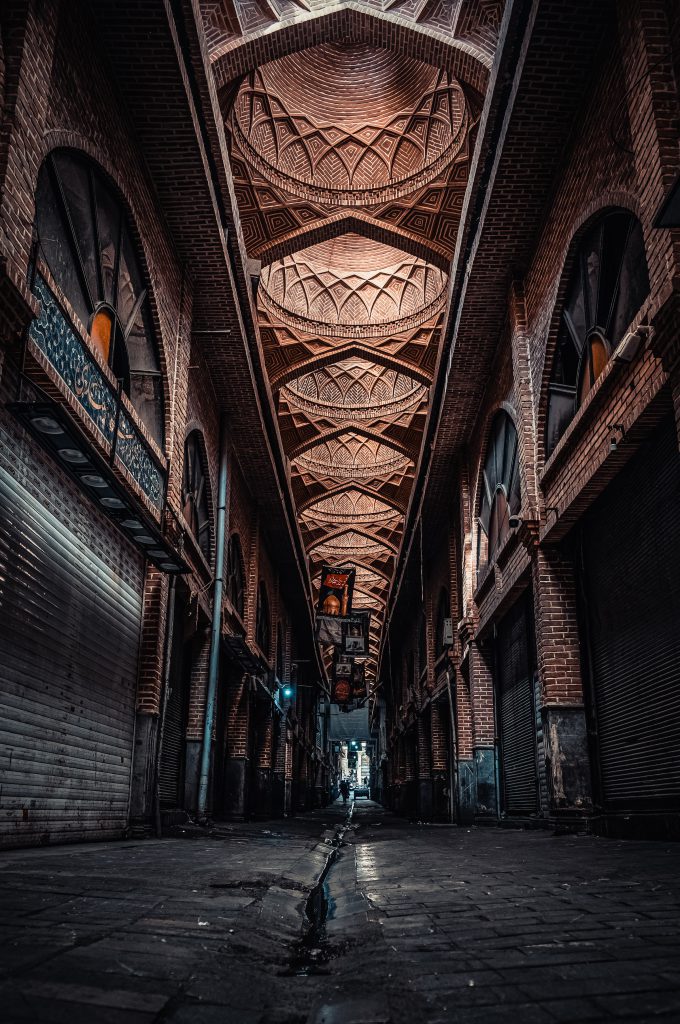
However, the bazaar’s evolution extended beyond its physical structure. It also became a focal point of political and social activity during this period. Revolutionary groups and political parties found the Tehran Grand Bazaar to be an ideal meeting place and a platform for disseminating their ideologies and propaganda. Thus, the bazaar not only symbolized economic vibrancy but also played a pivotal role in shaping the socio-political landscape of Tehran.
Today, as you wander through the Tehran Grand Bazaar, you can still sense the echoes of its storied past and feel the pulse of history that has shaped this magnificent marketplace into the extraordinary destination it is today.
Architecture of Tehran Grand Bazaar
The Tehran Grand Bazaar stands as a testament to the centuries of history that have shaped its fascinating architecture. While the market has evolved and transformed over time, it continues to embrace its rich heritage, combining traditional elements with modern influences.
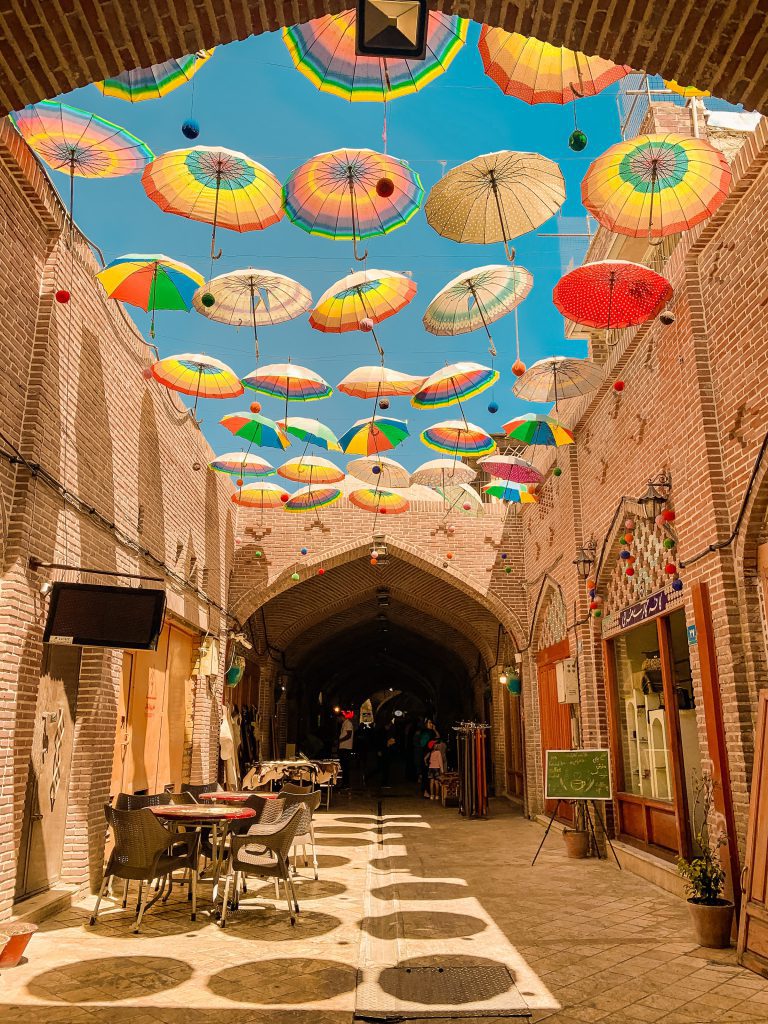
Antique Remnants: A Glimpse into the Past
The remnants of the old Tehran market include notable areas like Amir Bazaar, Sar Dar-e Sabze Meydan, Grand Chahar Souq, and parts associated with Jame Mosque. Among these, the Grand Chahar Souq stands out as one of the oldest sections, boasting a remarkable architectural style. The Chahar Souq is characterized by its octagonal space, adorned with intricate plasterwork and crowned by a distinctive short circular dome.
The architectural charm of these historical sections lies in their vaulted and dome-shaped roofs, designed to allow light to filter through cleverly placed holes and apertures in the brickwork. This technique not only illuminates the interiors but also casts an enchanting play of light and shadows, creating a captivating atmosphere.
A Blend of Tradition and Modernity
As the Tehran Grand Bazaar has embraced modernity, it has retained its traditional architectural elements. This fusion results in a complex and distinctive structure, where time-honored design principles coexist harmoniously with contemporary concepts.
The bazaar comprises several distinct sections, each with its unique purpose:
- Raaste: A lengthy path flanked by shops on both sides, offering an array of goods and products.
- Saraa: A central courtyard encircled by interconnected cells, each differing in terms of ground shape, number of floors, and architectural features like porches and corridors.
- Timcheh: Compact, covered spaces designed for the specific supply of particular products.
- Chaharsouq: The intersection of two main streets, characterized by its unique architecture and abundant interior decorations.
Winding corridors, archways, and traditional ventilators intertwine with modern structural elements, creating a captivating tapestry of architectural beauty. The Grand Bazaar is more than just a marketplace; it houses various places for leisure and reflection, including traditional teahouses, Zoor Khaneh (Traditional Persian Gymnasiums), public baths, mosques, and other religious monuments.
Over time, specialized regions called “Bazaarcheh” have emerged, catering to specific commodities, such as gold or beauty products, adding to the bazaar’s diversity and intrigue. As you explore the Tehran Grand Bazaar, the interplay of history, tradition, and innovation will undoubtedly leave you in awe of its architectural splendors.
Tehran Grand Bazaar Shops
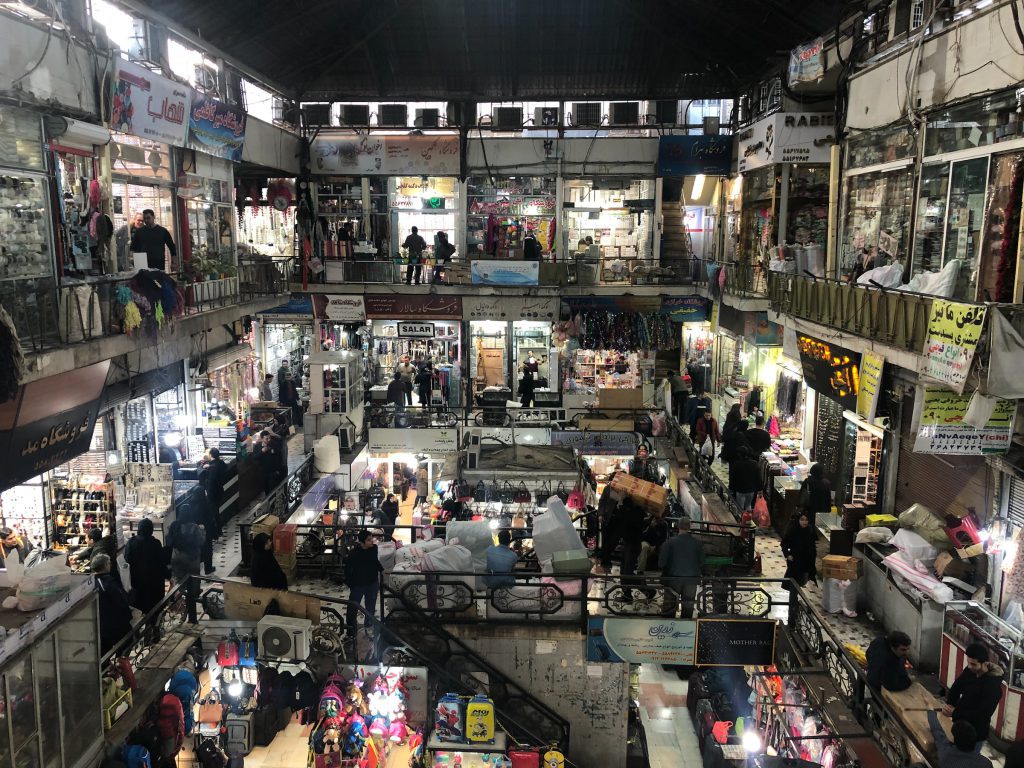
One of the defining characteristics of Tehran Grand Bazaar is the sheer diversity of bazaars within its sprawling confines. Whether you seek fresh produce, clothing, jewelry, or home decor, this marketplace offers an extensive array of goods. To navigate this retail wonderland effectively, it helps to know exactly where to head for your desired items.
Chahar Suq Bazaar
For culinary enthusiasts, Chahar Suq Bazaar is a treasure trove. Here, you’ll find an assortment of fresh and dried grapes, an abundance of fresh and dried vegetables, and a tempting selection of nuts. It’s the perfect place to stock up on ingredients for your culinary endeavors.
Jafari Bazaar
If you’re in search of fashion accessories like scarves, gloves, and hats, Jafari Bazaar is a bustling hotspot. What’s remarkable here is that the prices are often more budget-friendly compared to the stores and malls scattered throughout Tehran.
Zargarha Bazaar
For those with a penchant for precious metals, Zargarha Bazaar is a goldmine. The gold prices here tend to be more competitive, making it a suitable destination for purchasing gold in comparison to other gold shops.
Hajeb Ol-Dolleh Bazaar
Home decor enthusiasts will find themselves captivated by the offerings at Hajeb Ol-Dolleh Bazaar. This section boasts a wide range of products designed to beautify your living space, making it an excellent choice for those seeking home decor and accessories.
Koocheh Marvi (Marvi Alley)
If high-quality makeup products at reasonable prices are on your shopping list, Koocheh Marvi or Marvi Alley is the place to be. Here, you can indulge in a delightful shopping spree to enhance your beauty regimen.
The Tehran Grand Bazaar is a truly incredible destination to explore. There are so many different sections to explore, each with its own unique items and atmosphere. Whether you’re searching for something specific or just looking to soak up the lively vibe of this historic bazaar, the Tehran Grand Bazaar promises to be an unforgettable shopping experience. So why not check it out and see what treasures you can find? 🙂
Iran Souvenirs from Grand Bazaar Tehran
When you stroll through the enchanting labyrinth of Tehran Grand Bazaar, you’re not just wandering through a market; you’re embarking on a captivating journey through the heart of Iranian culture!
The bazaar offers an abundance of unique and exquisite souvenirs that serve as tokens of your unforgettable visit to this historic marketplace. From delicate Persian carpets that weave stories of tradition, to intricately designed jewelry that showcases the artistry of Iranian craftsmen, and a myriad of spices and teas that capture the essence of Persian cuisine, there’s no shortage of treasures to choose from.
Soak in the bustling atmosphere, strike up conversations with friendly shop owners, and immerse yourself in the vibrant tapestry of Iranian heritage. Don’t forget to take a piece of it home with you; these souvenirs from Tehran Grand Bazaar are not just trinkets; they are tangible memories of a remarkable experience.
Tehran Grand Bazaar Opening Hours
The Grand Bazaar Tehran is open from Saturday to Wednesday between 8:30 a.m. and 5:00 p.m. The shops outside the market are open until 8:00 p.m. On Thursdays, the shops inside the bazaar close at 2:00 p.m., while the shops outside the bazaar close at around 5:00 p.m. or later.
Tehran Bazaar is closed on Fridays and holidays, but some malls around the market are open on these days.
Best Time to Visit Grand Bazaar Tehran
The best time to visit the Grand Bazaar in Tehran is during the morning hours, ideally from 9 a.m. to around noon. There are a few compelling reasons for this choice:
- Avoid the Crowds: Mornings are relatively quieter, allowing you to explore the bazaar with more ease and comfort. The hustle and bustle tend to intensify as the day progresses, so starting early can help you beat the rush.
- Optimal Shopping Conditions: With fewer people around, you’ll have a better opportunity to engage with shop owners and peruse the vast array of products at your own pace. It’s an ideal time for unhurried shopping and bargaining.
- Cooler Weather: Tehran’s climate can be quite warm, especially during the summer months. Mornings offer cooler and more pleasant temperatures, making your visit more comfortable as you navigate the market’s many alleyways.
- Fresh Produce and Breakfast: Many local vendors set up early, offering fresh produce and breakfast options. This can be a fantastic opportunity to savor authentic Iranian breakfast and observe the market coming to life.
- Photography: If you’re a photography enthusiast, the soft morning light can enhance your pictures, capturing the bazaar’s charm and architecture in a magical way.
Where is Tehran Grand Bazaar?
Where is Tehran Grand Bazaar?
Tehran Grand Bazaar, a must-visit destination in the heart of the Iranian capital, is conveniently located in the southern part of Tehran and on Panzdah-e-Khordad Street (15th Khordad) Street. Navigating to this historical treasure is relatively straightforward, thanks to multiple access points:
- Main Entrance at Sabze Meydan: The primary entry point to the bazaar is situated at Sabze Meydan, directly across from the iconic Golestan Palace. This is your gateway to a world of shopping and cultural exploration.
- Metro Access: One of the most hassle-free ways to reach the Tehran Grand Bazaar is by taking the red metro line. Disembark at either Panzdah-e-Khordad station or Khayyam station, and you’ll find yourself within walking distance of the bazaar’s vibrant alleys and stalls.
- Taxi Convenience: For those who prefer taxis, line taxis are readily available from Sadeghieh and Azadi. These options offer the flexibility of personalized transportation to and from the bazaar.
- B.R.T. Buses: Tehran’s Bus Rapid Transit (B.R.T.) system provides another viable means of reaching the Grand Bazaar. You can opt for the Tajrish-railway line and alight at Meydan Monirieh or Imam Khomeini station. From there, you have the choice of taking a taxi, a regular bus, or even a leisurely walk to Panzdah-e-Khordad Street, where the bazaar awaits.
Best Restaurants in Tehran Grand Bazaar
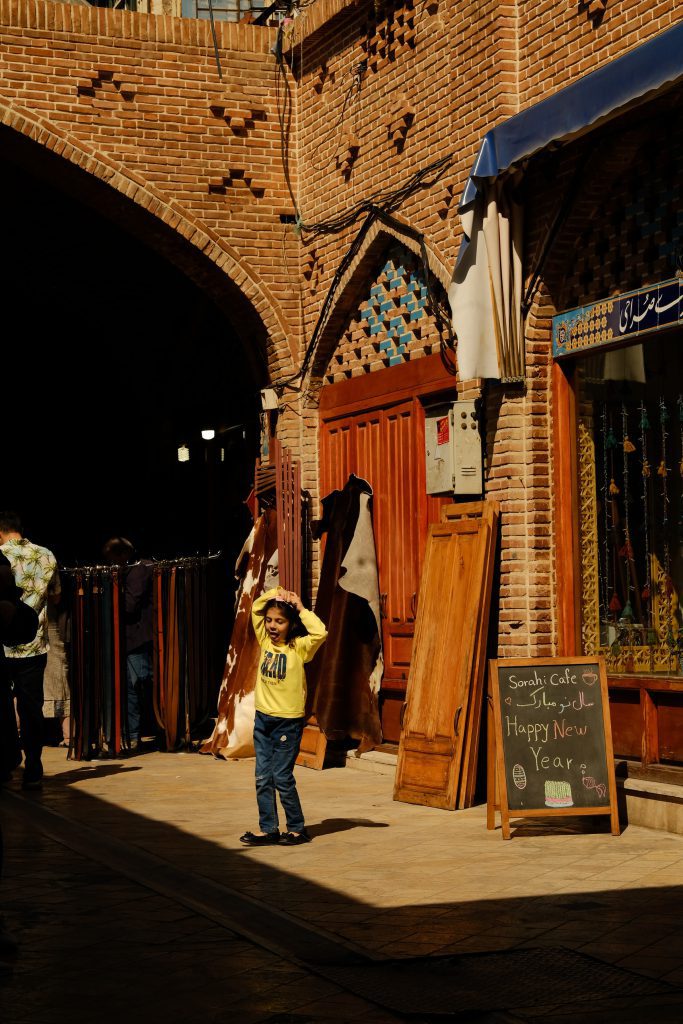
Within the bustling heart of Tehran Grand Bazaar, you’ll discover an array of culinary delights and historic gathering spots that add an extra layer of allure to this iconic marketplace. If you’re in the mood for traditional Persian cuisine, the likes of Moslem Restaurant, Shamshiri Restaurants, Khayyam Restaurants, Sharaf Al-Eslami Restaurant, Nayeb Restaurant, Haj Morshed Restaurants, and Timcheh Akbarian Restaurant are your go-to destinations. These age-old eateries have perfected the art of crafting delectable dishes that are bound to tantalize your taste buds.
For a quick and satisfying bite, venture into Marvi Alley, where you can savor mouthwatering falafel sandwiches. And as you stroll through the enchanting alleys, don’t miss the chance to step into the past at the charming Haj Ali Darvish Tea House, which stands as the oldest and coziest café nestled within the Grand Bazaar. These establishments provide not only nourishment but also a glimpse into the history and culture that make the Tehran Grand Bazaar a true gem in the heart of Iran’s capital.
Best Hotels Near Tehran Grand Bazaar
For those seeking comfortable accommodations in the vicinity of the Tehran Grand Bazaar, a wide range of options is available, catering to diverse budgets and preferences. Travelers looking for a traditional Iranian experience can consider the Tehran Traditional Airan Hostel, a welcoming place that offers an authentic atmosphere and the chance to connect with locals. On the other hand, if you prefer a 2-star experience, the Amirkabir Hotel, Okhovvat Hotel, Ziba Hotel, and Fars Hotel provide affordable and convenient stays. For a cozier atmosphere, the 1-star Samen Hotel offers a relaxed setting in a great location.
If you’re in search of a more luxurious stay, the 4-star Ferdowsi Grand Hotel and the 3-star Shiraz Hotel provide a comfortable and well-appointed experience. Additionally, for those on a tighter budget, the 1-star Khayyam Hotel, 2-star Golestan Hotel, and Arman Hotel offer wallet-friendly options. And if you prefer a more intimate and social environment, Seven Hostel, Tehran Heritage Hostel, and Hi Tehran Hostel are welcoming and vibrant choices. Whether you’re visiting for business or leisure, the accommodations in and around Tehran Grand Bazaar ensure a memorable and convenient stay, allowing you to fully immerse yourself in the rich tapestry of this historical and cultural epicenter.
Attractions Near Tehran Grand Bazaar
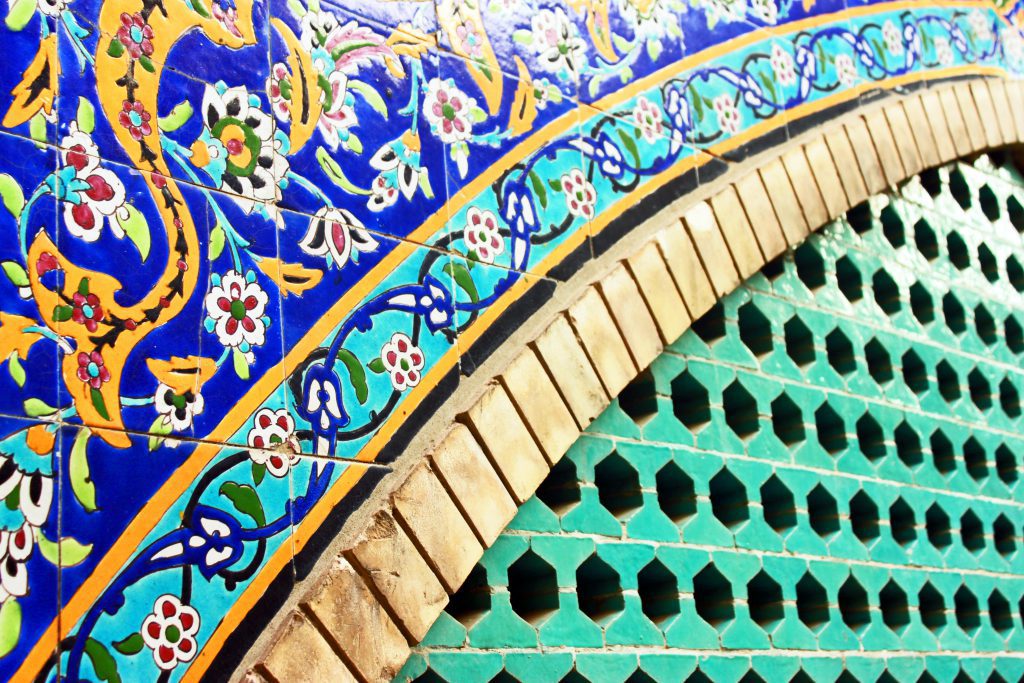
The allure of Tehran Grand Bazaar extends beyond its labyrinthine lanes and historic charm, as it conveniently places you within reach of some of Tehran’s most captivating attractions. Just a stone’s throw away, the UNESCO-listed Golestan Palace beckons with its opulent architecture and lush gardens. Additionally, the National Museum of Iran offers a captivating journey through the country’s rich history, housing an impressive collection of artifacts.
Nearby, the tranquil ambiance of Imam Khomeini Square invites moments of reflection, while the vibrant atmosphere of the Great Bazaar and the historic Imam Khomeini Mosque provide further glimpses into Tehran’s cultural tapestry. Tehran Grand Bazaar serves as a strategic gateway, offering travelers the opportunity to explore a plethora of enchanting sites and experiences within the heart of the city.
FAQs about Tehran Grand Bazaar
Q1: What is the biggest bazaar in Iran?
A1: Iran has numerous and vast traditional markets that can be mentioned Tabriz Grand Bazaar, Tehran Grand Bazaar, Shiraz Vakil Bazaar, etc.
Q2: How big is Tehran Grand Bazaar?
A2: The Tehran Grand Bazaar, one of the largest and most expansive covered markets in the world, covers a vast area of approximately 10 kilometers (6.2 miles) of labyrinthine alleys, interconnected courtyards, and bustling stalls. Its size is truly awe-inspiring, making it a city within a city and a prominent landmark in the heart of the Iranian capital.
Q3: What time does the bazaar open in Tehran?
A3: The Grand Bazaar Tehran is open from Saturday to Wednesday 8:30 am – 5:00 pm. Shops outside the market are open until 8:00 pm. On Thurs, shops inside close at 2:00 pm while those outside close at 5:00 pm or later. Closed on Fri and holidays, but some malls around the market may be open.
Q4: What is the history of Tehran Grand Bazaar?
A4: Tehran Grand Bazaar has a long history, dating back to antiquity. The current structures were built during the Safavid era, but it has been a bustling open-air marketplace for centuries. In the 19th century, it underwent extensive renovations and became a commercial and political center, cementing its significance in Tehran’s history.
Q5: What is the famous bazaar in Tehran?
A5: The famous bazaar in Tehran is known as the “Grand Bazaar of Tehran” or “Bazaar-e Bozorg-e Tehran” in Persian. It is one of the oldest and largest covered marketplaces in the world, offering a wide variety of goods and a rich cultural experience for visitors.
Q6: Why is the Grand Bazaar Tehran so famous?
A6: The Grand Bazaar in Tehran is famous for its immense size, rich history, and vibrant culture. It’s one of the world’s largest covered markets, with a history dating back centuries. The bazaar offers a unique blend of traditional and modern shopping experiences, making it a hub of commerce, culture, and art in the heart of Iran’s capital.
Q7: What is the oldest bazaar in Tehran?
A7: The oldest bazaar in Tehran is known as the “Grand Bazaar of Tehran,” often simply referred to as the Tehran Grand Bazaar.
ToIranTour: Take a Responsible Trip to the Capital of Iran
Embark on a unique journey to Tehran Grand Bazaar with To Iran Tour services and discover this mesmerizing marketplace with a responsible touch. Our commitment to responsible tourism ensures that your visit leaves a positive impact on the local community while providing you with a rich and authentic experience. As you wander through the historic alleyways, savor local flavors, and immerse yourself in the vibrant culture, you’ll be contributing to the preservation of Iran’s heritage. Join us in creating unforgettable memories while leaving a lasting, positive impression. Tehran Grand Bazaar awaits, and with To Iran Tour, you can explore it responsibly and ethically, knowing that your travel experience benefits both you and the communities you visit.

